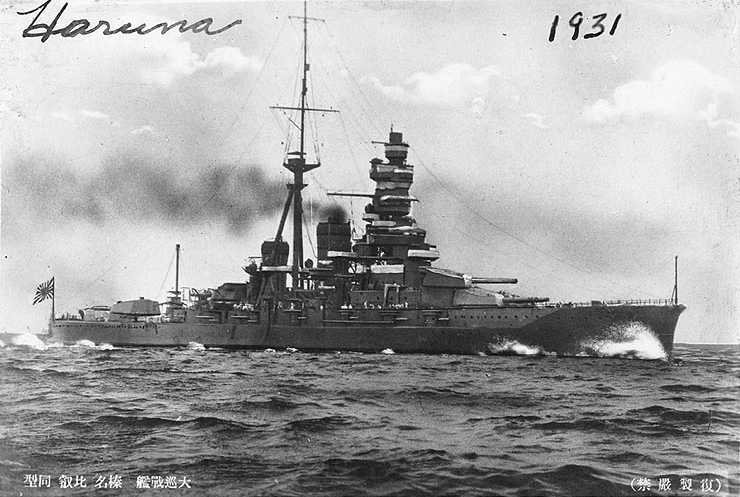
This could well be said to be the best battleship gun built by Japan, as it was quite accurate and reliable. The original design was by the famous British armament firm of Vickers and guns manufactured by that firm were first used to arm the battlecruiser Kongô which was built at the Vickers-Armstrong yard at Barrow.
Nomenclature for these weapons is somewhat complicated. The original design was submitted by Vickers to the Japanese in November 1910. In an effort to hide their true size, Vickers designated these guns on their internal documents as the 12-in Vickers Mark "J" and the Japanese documented them as the 12-in Meiji 43 Type (the 43rd year of the Meiji era being 1910). Later, the guns built by Vickers were known as the 14-in Vickers Mark "A" and to the Japanese as the 14-in 43rd Year Type (Model 1910). Guns manufactured in Japan were known as 14-in 41st Year Type (Model 1908). In 1917, when the Japanese converted to metric, all of these guns were then designated as 36 cm (14.2 inches) but their bores remained unchanged at 14.0 inches (35.6 cm). For more information on Japanese designations, see Gun Data.
In addition to those guns on Kongô, Vickers supplied a number of complete guns and individual forgings to the Japanese for a few years, but most guns were built by Kure Arsenal and by Japan Steel Works, LTD (Muroran Plant). A total of about 100 guns from all sources were produced. There were several versions of the Japanese type, but they and the Vickers guns had similar performance and can be considered together. The Vickers guns were the customary full-length wire wound type and used cannelured rings at the tube shoulders to reduce "steel choke" problems. The early 41st Year Type guns were similar, but later ones are believed to have had the inner A tube radially expanded into position. Vickers "pure couple" breech mechanism was used with a Welin block on all of these guns, similar to British guns of the same era.
| Designation | Vickers built guns - Vickers designation: 14"/45 (35.6 cm) Vickers Mark "A"
Vickers built guns - Japanese designation: 14"/45 (35.6 cm) 43rd Year Type (Model 1910) Japanese built guns (before 1917): 14"/45 (35.6 cm) 41st Year Type (Model 1908)
Official Designation: 45 caliber 41st Year Type 36 cm Gun |
|---|---|
| Ship Class Used On | Kongô, Ise and Fusô Classes |
| Date Of Design | Vickers design submitted to Japan in 1910 |
| Date In Service | 1913 |
| Gun Weight | 189,586 lbs. (86,000 kg) |
| Gun Length oa | 648.4 in (16.469 m) |
| Rifling Length 1 | 540 in (13.737 m) |
| Grooves | (84) 0.12 in deep x 0.349 in (2.048 mm x 8.865 mm) |
| Lands | 0.175 in (4.435 mm) |
| Twist | Uniform RH 1 in 28 |
| Chamber Volume | 17,996 in3 (294.9 dm3) |
| Rate Of Fire | 2 rounds per minute |
- ^Rifling shown as for Model Type II and III barrels. Model Type III2 and III4 barrels had the same chamber volume, but had a 0.04 in (0.10 cm) shorter chamber and 1.22 in (3.1 cm) less rifling length.
| Type | Bag |
|---|---|
| Projectile Types and Weights 1a 2a | World War I
APC Type 3: N/A, but probably 1,400 lbs. (635 kg) Common Type 3 HE: N/A, but probably 1,400 lbs. (635 kg) 1925
1928
World War II
|
| Bursting Charge | APC Type 91: 24.5 lbs. (11.1 kg)
Common Type 0 HE: 65.1 lbs. (29.5 kg) Others: N/A |
| Projectile Length | APC Type 91: 60.03 in (152.5 cm)
Common Type 0 HE: 47.25 in (120.0 cm) Common Type 3 IS: 55.1 in (140 cm) Others: N/A |
| Propellant Charge 7a | 313.8 lbs. (142.3 kg) 85 DC |
| Muzzle Velocity | APC Type 91: 2,526 - 2,543 fps (770 - 775 mps)
Common Type 0 HE: 2,641 fps (805 mps) Common Type 3 IS: 2,641 fps (805 mps) Others: N/A |
| Working Pressure | 19.0 to 19.2 tons/in2 (3,000 to 3,020 kg/cm2) |
| Approximate Barrel Life | 250 - 280 rounds |
| Ammunition stowage per gun | About 90 rounds |
- ^The Common Type 3 HE shell of the World War I period were derived from HE shells imported from Britain and was adopted on 26 May 1915. The Common Type 3 should not be confused with the Common Type 3 Incendiary Shrapnel (IS) rounds used during World War II. The original Type 3 had a shimose filler and had a tendency to detonate on impact, similar to British shells of the era. It is probable that APC and CPC shells were also imported from Britain at this time but I have been unable to confirm that hypothesis.
- ^The APC Type 3 was adopted in 1917. Following World War I, the Japanese obtained some German AP shells and also purchased some British Hadfield AP shells in 1924. Examination of these examples and the results of their own extensive firing trials resulted in the APC Type 5 which was adopted on 15 June 1925. This was superseded by the APC No. 6 which was adopted on 17 November 1928. APC No. 6 was essentially similar to the Type 5 in terms of armor penetration but was better protected from premature detonation and had enhanced underwater performance. APC No. 6 was redesignated as the Type 88 on 6 April 1931. On that same date, the improved APC Type 91 was adopted.
- ^Type 91 shells were all 6/∞ crh with boat tail and two copper driving bands. The diameter of the bourrelet was 13.970 in (35.484 cm). AP Cap, cap head and windshield together weighed 229 lbs.
- ^Dye for AP shells was introduced in 1941 and those projectiles using dye were designated as Type 1. The following dye colors were assigned:
Kongô: Red
Haruna: Black
Kirishima: Blue
Hiei: None (White)
Fusô: N/A
Yamashiro: N/A
Ise: Orange
Hyuga: N/A - ^Common Type 0 HE was supplied with time fuzes for AA defense. US Naval Technical Mission to Japan report O-19 says that this round had an effective radius of 64.1 yards (59 m) but this seems to be optimistic.
- ^IS is my abbreviation for the incendiary shrapnel round (sankaidan) intended for AA use.
- ^The propellant charge was in four bags.
| Elevation | Range | Striking Velocity | Angle of Fall |
|---|---|---|---|
| 2.6 degrees | 5,470 yards (5,000 m) | 2,198 fps (670 mps) | 3.5 |
| 6.1 degrees | 10,940 yards (10,000 m) | 1,890 fps (576 mps) | 7.5 |
| 9.9 degrees | 16,400 yards (15,000 m) | 1,673 fps (510 mps) | 12.4 |
| 14.4 degrees | 21,870 yards (20,000 m) | 1,506 fps (459 mps) | 18.9 |
| 20.0 degrees | 27,340 yards (25,000 m) | 1,378 fps (420 mps) | 27.5 |
| 28.7 degrees | 32,810 yards (30,000 m) | 1,358 fps (414 mps) | 35.9 |
| 43.0 degrees
(maximum elevation of turret) |
38,770 yards (35,450 m) | --- | --- |
| Elevation | Range |
|---|---|
| 43.0 degrees | 30,650 yards (28,025 m) |
| Designation | Two-gun Turrets
Kongô (4), Ise (6) and Fusô (6) |
|---|---|
| Weight 1b | Kongô: About 654 tons (664 mt)
Ise and Fusô: About 688 tons (699 mt) |
| Elevation 2b | As commissioned: -5 / +25 degrees
As modified in the 1920s: -5 / +33 degrees As rebuilt in the 1930s: -5 / +43 degrees |
| Elevation Rate | 5 degrees per second |
| Train 3b | Forward and aft turrets: about -150 / +150 degrees
Amidships turrets: about 30 to 150 degrees on either side |
| Train Rate | 3 degrees per second |
| Gun recoil | N/A |
| Loading Angle 4b | All except Fusô: -5 to +20 degrees
Fusô: +5 degrees |
- ^The weight differences were mainly the result of thicker armor on the battleship turrets.
- ^In September 1920, the battlecruiser Haruna was badly damaged when she suffered a breech explosion in 'A' turret, caused by an error while loading. During repairs, the gun elevation in all her turrets was increased by enlarging the gun port openings. Her sisters and later capital ships were similarly modified during the 1920s. An additional increase in elevation was achieved in the 1930 rebuilds by deepening the gun wells and lowering the revolving structure down into the ships. Ise and Hyuga lacked sufficient depth in the aftmost two turrets to allow this last change, so only the four forward and amidships turrets were modified for greater elevations. It should be noted that even the original +25 degree elevation was greater than that of contemporary British designs which were generally limited to +15 or +20 degree elevations.
- ^Q turret on the Kongô class was in a more favorable position than those on earlier British battlecruisers, increasing its firing arc to about 60 degrees before the beam and 90 degrees abaft it on either side, although it could not fire directly aft at elevations below about 10 degrees.
- ^US Naval Technical Mission to Japan report O-54(N) states that guns meant to be loaded at high elevations had "ridges around the compression slope, to aid in gripping the projectile rotating bands and prevent the projectile from slipping back after seating."
- These mountings used Kenyon Doors to transfer projectiles onto the turret stalks. Auxiliary electric power was provided. Magazines were above the shell rooms in the original British design for the Kongô and her sisters, although later classes had this arrangement reversed, showing the influence of a similar change in British thinking of the 1920s. When the Kongô class was modernized, the magazines and shell rooms were redone to the new standard. Compressed air runout was added in the 1920s rebuilds.
- The gun axes were 90 in (229 cm) apart.
- During gunnery practice on 5 May 1942, the left gun breech of Turret #5 on Hyuga suffered a catastrophic failure and the resulting explosion and fire killed fifty-one officers and crewmen. During repairs at Kure over the next few weeks, Turret #5 was removed from the ship and replaced with a circular armor plate atop the barbette. Four triple 25 mm gun mounts were placed on top of the plate. Later during 1943, the after two turrets and barbettes on Ise and Hyuga were removed and these ships were then converted into hybrid battleship-seaplane carriers. See the Naval Technical Board essay The Japanese Ise and Hyuga Hybrid Battleship-Carriers for additional information.
- The US Naval Technical Mission to Japan report O-47(N)-1 states that "Japanese major caliber turrets (14 and 16-inch) are all of old design and were copied from the British-built turrets for the BB Kongô. In general arrangement and in most details, they are similar to the British 15-inch turrets, but some improvements have been made by the Japanese . . .[including] Better flash tightness in gunhouses and working chambers. All battleships were fitted with longitudinal flashtight bulkheads between the guns, and between the gun loading hoists in the working chambers."
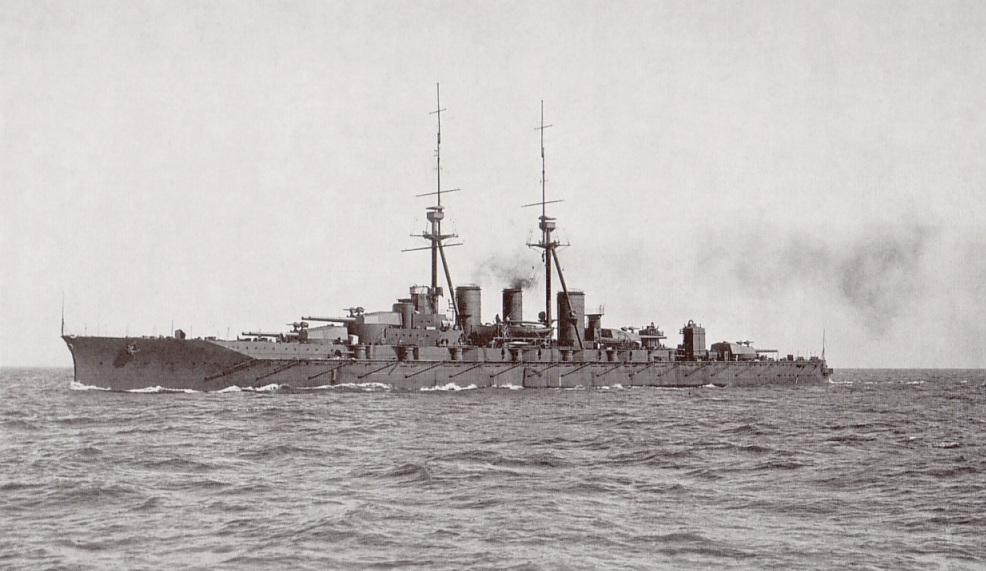
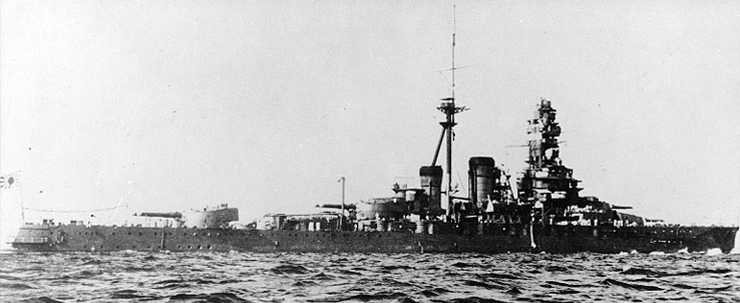

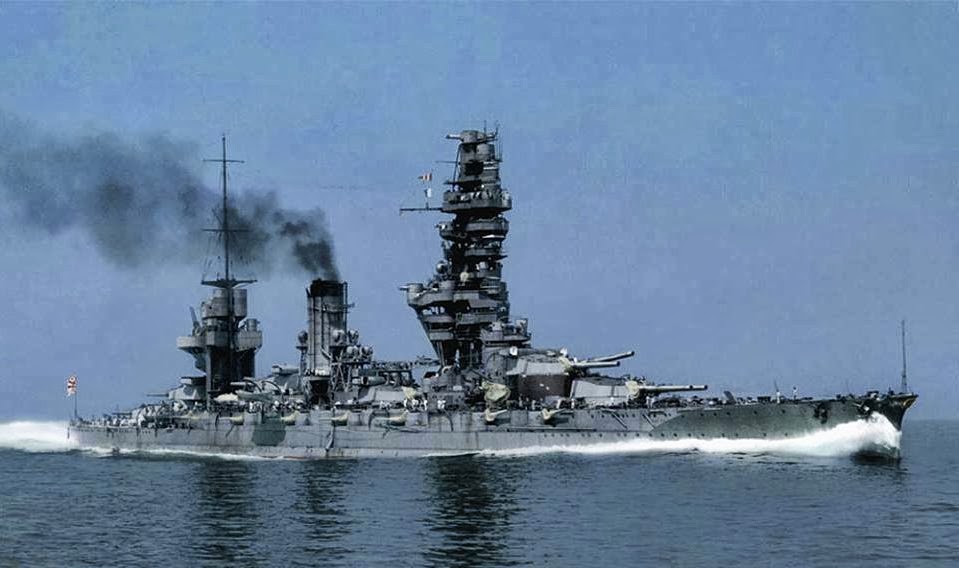
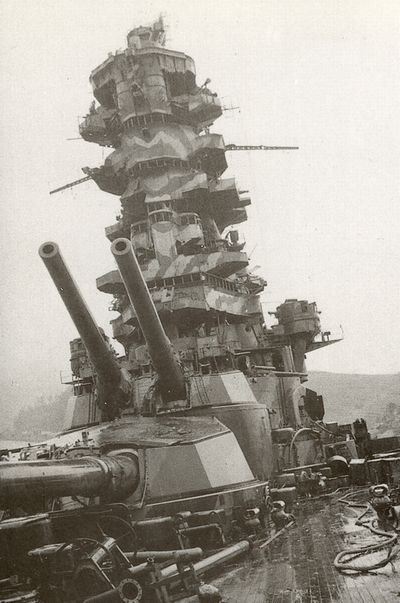
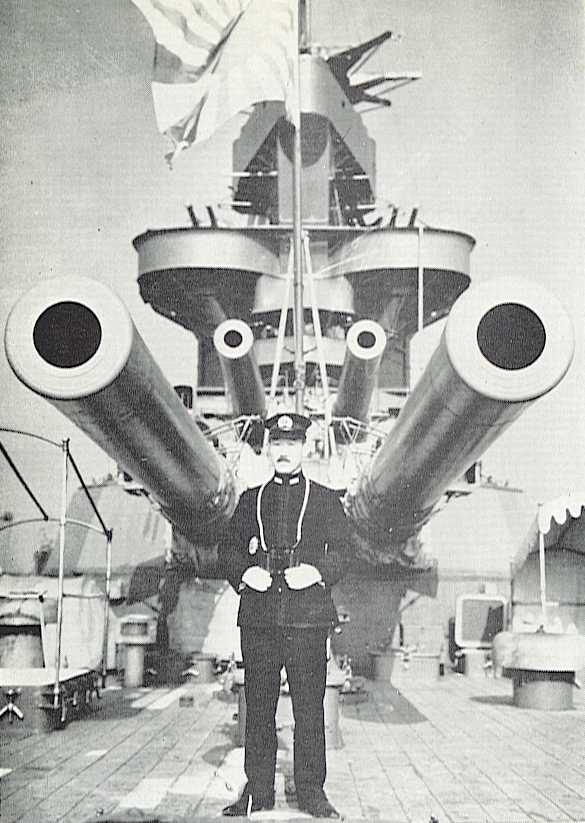
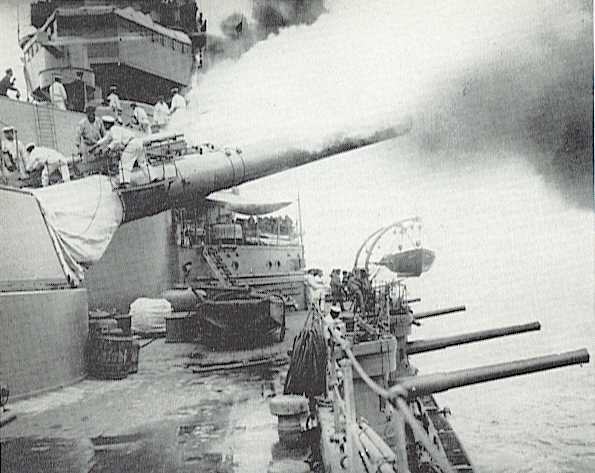
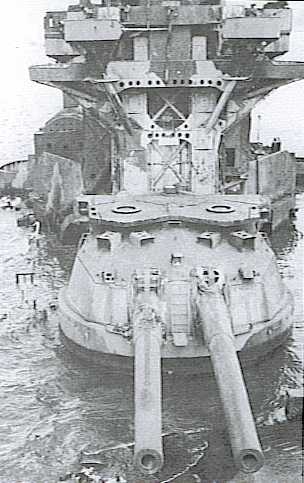
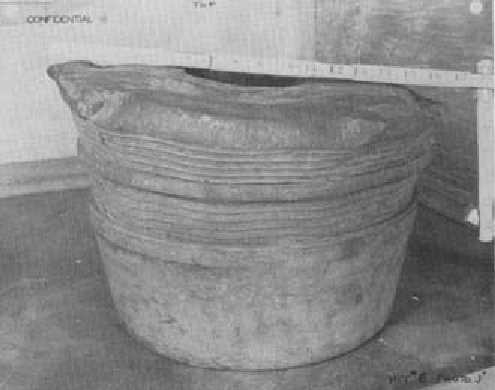
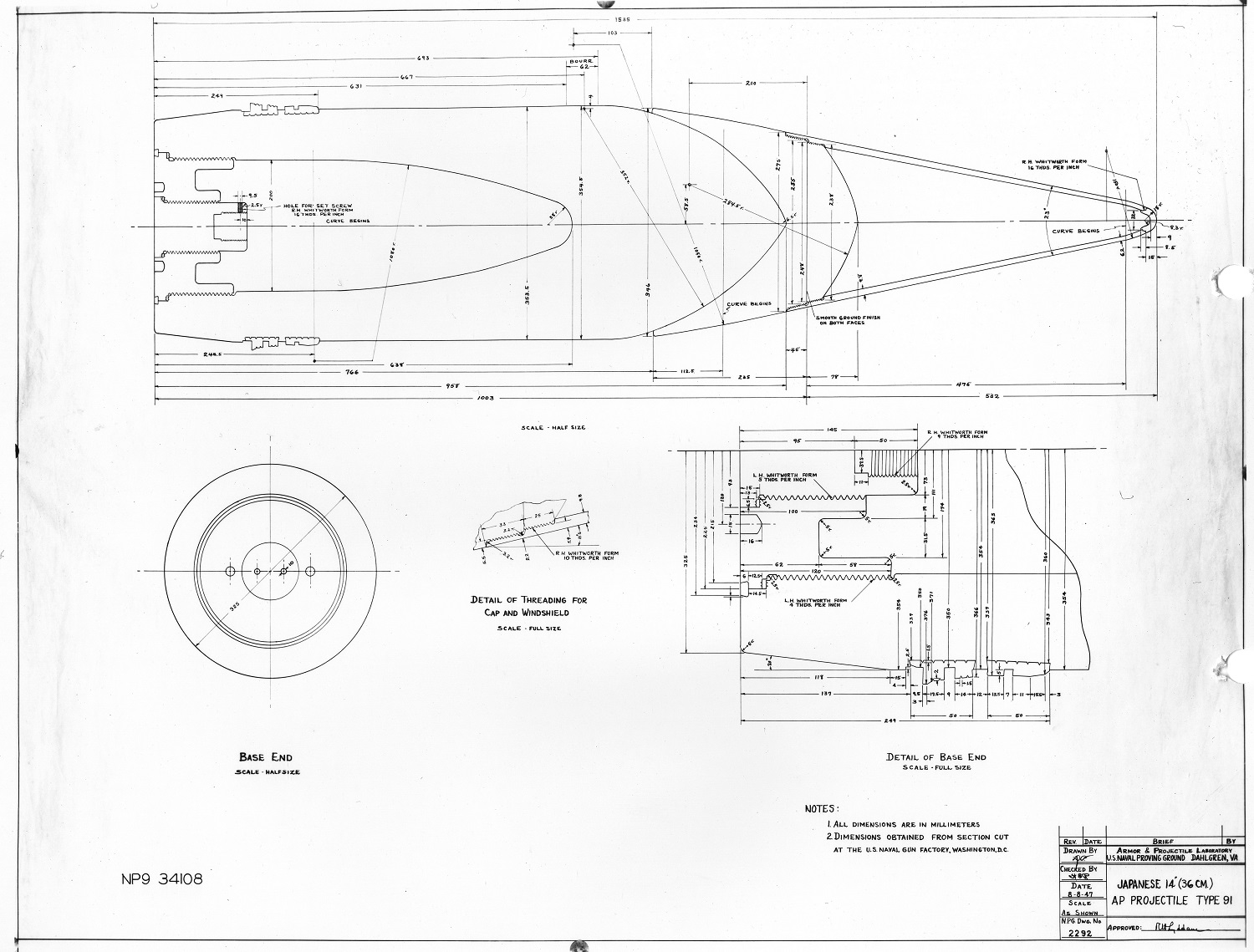
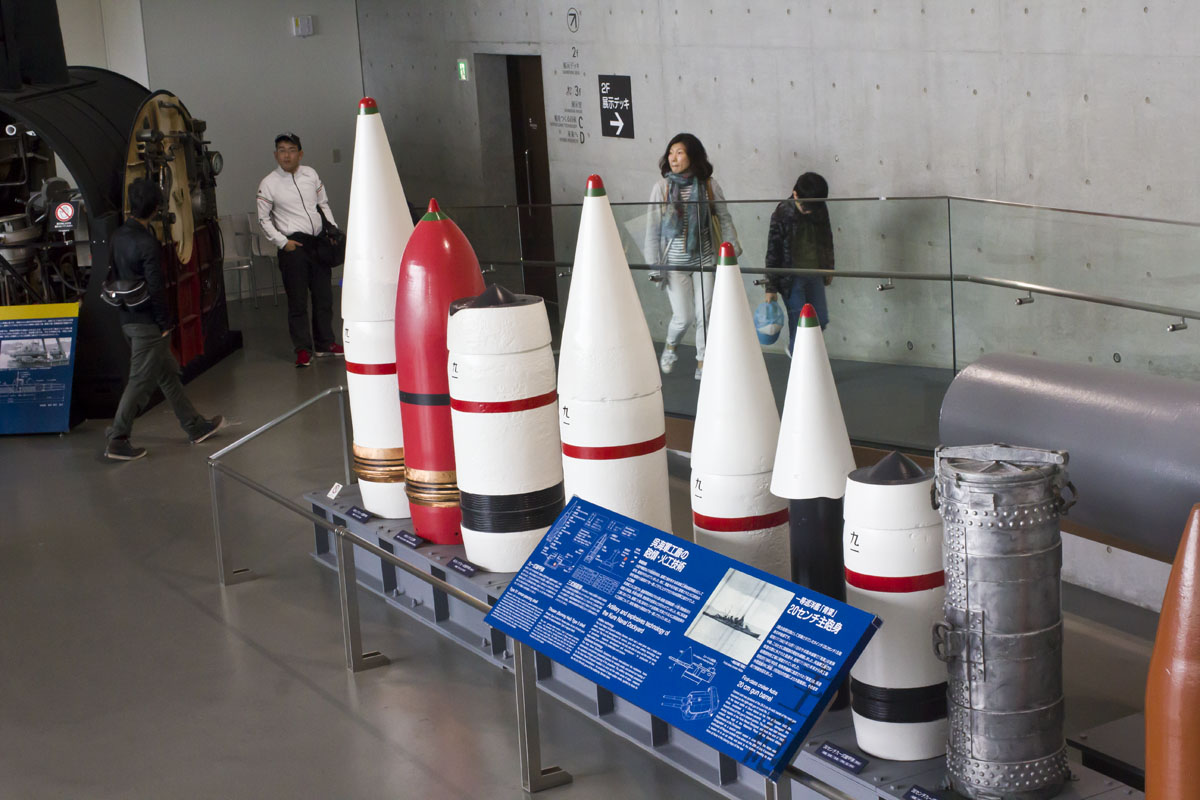
From left to right:
Type 91 46 cm AP shell
Type 3 46cm Shosan shell (sankaidan shell)
Type 91 46 cm AP shell body
Type 91 41cm AP shell
Type 91 36 cm AP shell
Type 91 36 cm ballistic cap
Type 91 36 cm AP shell body
Type 91 36 cm AP shell powder canister
30 cm main gun shell.
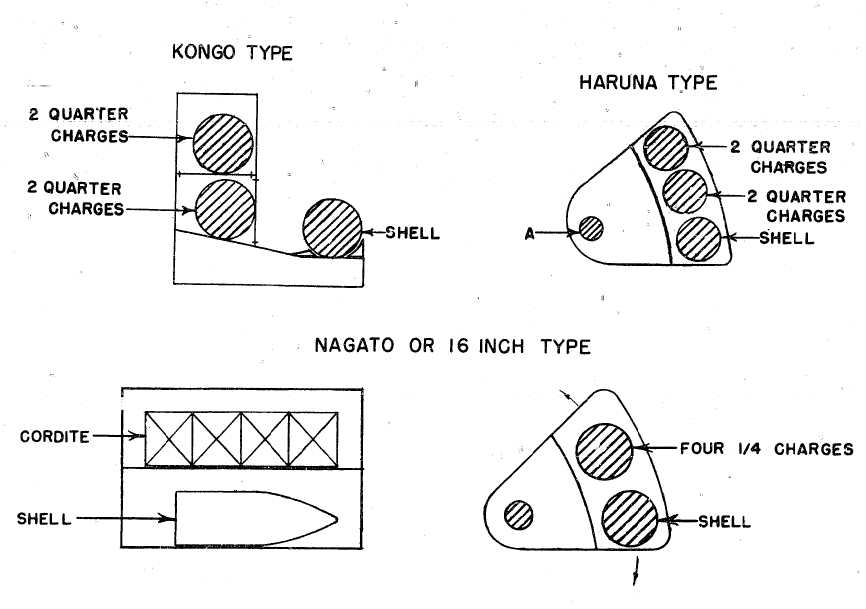
Images at The Vickers Photographic Archive
Note the Kenyon Doors in photograph 4619.
"Naval Weapons of World War Two" by John Campbell
"The Big Gun: Battleship Main Armament 1860-1945" by Peter Hodges
"Battleships of World War I" by Peter Hore
"Japanese Cruisers of the Pacific War" by Eric Lacroix and Linton Wells II
"The World Wonder'd: What Really Happened Off Samar" by Robert Lundgren
"Japanese Warships of World War II" by Anthony Watts
---
US Naval Technical Mission to Japan report O-19: Japanese Projectiles General Types
US Naval Technical Mission to Japan report O-47(N)-1: Japanese Naval Guns and Mounts-Article 1, Mounts Under 18"
US Naval Technical Mission to Japan report O-54(N): Japanese Naval Guns
NPG Report No. 269: Ballistic Test and Metallurgical Examination of Japanese 8", 14", 16" and 18" Armor Piercing Projectiles
---
Combined Fleet TROM for Hyuga (accessed on 19 February 2009)
---
Special help from Yasufumi Kunimoto (Manager, Japan Steel Works, LTD) and Robert Lundgren
13 October 2007 - Benchmark
26 February 2009 - Added information regarding turret explosion on Hyuga
28 September 2010 - Added photograph of shell fragment
01 May 2012 - Added sketch of Shell Cages
11 July 2015 - Added to note about splash colors
01 November 2015 - Added photograph of projectiles
20 December 2015 - Added photographs of Kongô, Fusô, Ise, salvaged turret and changed Vickers Photographic Archive links to point at Wayback Archive
28 October 2016 - Converted to HTML 5 format
26 May 2018 - Reorganized notes and added colorized photograph of Fusô
21 March 2019 - Added note regarding time fuzes on Common Type 0 HE
17 December 2019 - Moved turret photographs to 40 cm/45 3rd Year Type datapage
18 December 2021 - Corrected first name of Vice-Admiral Takahashi
11 April 2022 - Minor changes
01 November 2023 - Added sketch of Type 91 APC
